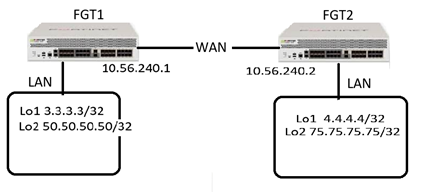- Support Forum
- Knowledge Base
- Customer Service
- Internal Article Nominations
- FortiGate
- FortiClient
- FortiADC
- FortiAIOps
- FortiAnalyzer
- FortiAP
- FortiAuthenticator
- FortiBridge
- FortiCache
- FortiCare Services
- FortiCarrier
- FortiCASB
- FortiConverter
- FortiCNP
- FortiDAST
- FortiData
- FortiDDoS
- FortiDB
- FortiDNS
- FortiDLP
- FortiDeceptor
- FortiDevice
- FortiDevSec
- FortiDirector
- FortiEdgeCloud
- FortiEDR
- FortiEndpoint
- FortiExtender
- FortiGate Cloud
- FortiGuard
- FortiGuest
- FortiHypervisor
- FortiInsight
- FortiIsolator
- FortiMail
- FortiManager
- FortiMonitor
- FortiNAC
- FortiNAC-F
- FortiNDR (on-premise)
- FortiNDRCloud
- FortiPAM
- FortiPhish
- FortiPortal
- FortiPresence
- FortiProxy
- FortiRecon
- FortiRecorder
- FortiSRA
- FortiSandbox
- FortiSASE
- FortiSASE Sovereign
- FortiScan
- FortiSIEM
- FortiSOAR
- FortiSwitch
- FortiTester
- FortiToken
- FortiVoice
- FortiWAN
- FortiWeb
- FortiAppSec Cloud
- Lacework
- Wireless Controller
- RMA Information and Announcements
- FortiCloud Products
- ZTNA
- 4D Documents
- Customer Service
- Community Groups
- Blogs
- Fortinet Community
- Knowledge Base
- FortiGate
- Technical Tip: How to check BGP advertised and rec...
- Subscribe to RSS Feed
- Mark as New
- Mark as Read
- Bookmark
- Subscribe
- Printer Friendly Page
- Report Inappropriate Content
Created on
10-29-2019
08:37 AM
Edited on
10-30-2025
05:02 AM
By
![]() Jean-Philippe_P
Jean-Philippe_P
Description
This article describes how to check BGP-advertised and received routes on a FortiGate.
Scope
FortiGate.
Solution

Outputs from FortiGate1:
FortiGate1# get router info bgp summary
BGP router identifier 3.3.3.3, local AS number 65003
BGP table version is 11
2 BGP AS-PATH entries
0 BGP community entries
Neighbor V AS MsgRcvd MsgSent TblVer InQ OutQ Up/Down State/PfxRcd
10.56.240.2 4 65004 670 667 10 0 0 2d15h37m 2
Total number of neighbors 1
BGP table version is 11, local router ID is 3.3.3.3
Status codes: s suppressed, d damped, h history, * valid, > best, i - internal
Origin codes: i - IGP, e - EGP, ? - incomplete
Network Next Hop Metric LocPrf Weight RouteTag Path
*> 3.3.3.3/32 10.56.240.1 100 32768 0 i
*> 50.50.50.50/32 10.56.240.1 100 32768 0 i
Total number of prefixes 2
Commands to verify routes that FGT1 is receiving from the BGP peer FGT2 are:
get router info bgp neighbors <neighbor IP> routes --> Command 'get router info bgp neighbors <neighbor IP> routes' shows only filtered (in) received routes. If received routes aren’t filtered, then the output of these commands will be the same.
BGP table version is 11, local router ID is 3.3.3.3
Status codes: s suppressed, d damped, h history, * valid, > best, i - internal
Origin codes: i - IGP, e - EGP, ? - incomplete
Network Next Hop Metric LocPrf Weight RouteTag Path
*> 4.4.4.4/32 10.56.240.2 0 0 65004 i
*> 75.75.75.75/32 10.56.240.2 0 0 65004 i
Total number of prefixes 2
FortiGate1 # get router info bgp neighbors 10.56.240.2 route
BGP table version is 11, local router ID is 3.3.3.3
Status codes: s suppressed, d damped, h history, * valid, > best, i - internal,
S Stale
Origin codes: i - IGP, e - EGP, ? - incomplete
Network Next Hop Metric LocPrf Weight RouteTag Path
*> 4.4.4.4/32 10.56.240.2 0 0 65004 i
*> 75.75.75.75/32 10.56.240.2 0 0 65004 i
Total number of prefixes 2
FortiGate1 # get router info routing-table bgp
Routing table for VRF=0
B 4.4.4.4/32 [20/0] via 10.56.240.2, port1, 00:50:26
B 75.75.75.75/32 [20/0] via 10.56.240.2, port1, 00:50:26
FortiGate1 # config router prefix-list
edit "ALLOW-ONLY-75"
config rule
edit 1
set prefix 75.75.75.75 255.255.255.255
unset ge
unset le
next
end
next
end
FortiGate1 # config router bgp
set as 65003
set router-id 3.3.3.3
config neighbor
edit "10.56.240.2"
set soft-reconfiguration enable
set prefix-list-in "ALLOW-ONLY-75" <----------------- prefix-list filtering received routes.
set remote-as 65004
next
end
The output below shows all received routes.
FortiGate1 # get router info bgp neighbors 10.56.240.2 received-routes
BGP table version is 11, local router ID is 3.3.3.3
Status codes: s suppressed, d damped, h history, * valid, > best, i - internal
Origin codes: i - IGP, e - EGP, ? - incomplete
Network Next Hop Metric LocPrf Weight RouteTag Path
*> 4.4.4.4/32 10.56.240.2 0 0 65004 i
*> 75.75.75.75/32 10.56.240.2 0 0 65004 i
Total number of prefixes 2
FortiGate1 # get router info bgp neighbors 10.56.240.2 route
BGP table version is 11, local router ID is 3.3.3.3
Status codes: s suppressed, d damped, h history, * valid, > best, i - internal,
S Stale
Origin codes: i - IGP, e - EGP, ? - incomplete
Network Next Hop Metric LocPrf Weight RouteTag Path
*> 75.75.75.75/32 10.56.240.2 0 0 0 65004 i
Total number of prefixes 1
Routing table for VRF=0
B 75.75.75.75/32 [20/0] via 10.56.240.2, port1, 00:55:45
Can filter specific subnets or routes based on AS number, etc, with the 'grep' keyword:
get router info bgp neighbors <x.x.x.x> advertised-routes | grep < network subnet>
get router info bgp neighbors <x.x.x.x> advertised-routes | grep <AS number>
get router info6 bgp neighbors
get router info6 bgp network bgp
get router info6 bgp neighbors <x.x.x.x> advertised-routes
Note:
For example:
% Inbound soft reconfiguration not enabled
config router bgp
config neighbor
edit "10.56.240.2
set soft-reconfiguration enable
end
BGP prefers the route with the longest prefix length when multiple routes exist to the same destination.
set network-import-check disabled
set network-import-checkenable <-- Enable by default.
config network <---
edit 1
set prefix 75.75.75.75 255.255.255.255
set network-import-check disable <-- This will override the global 'enable' settings for this prefix.
end
end
network-import-check {global | enable | disable} <-----global: use global network synchronization value (default), enable: enable network synchronization per prefix, disable: disable network synchronization per prefix.
The Fortinet Security Fabric brings together the concepts of convergence and consolidation to provide comprehensive cybersecurity protection for all users, devices, and applications and across all network edges.
Copyright 2025 Fortinet, Inc. All Rights Reserved.